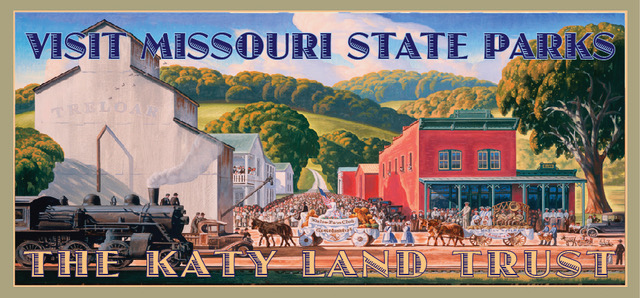For More Than 10 Years, Treloar Banners Have Served as a ‘Great Asset to the Katy Trail’
By Karen Cernich Dickhut
Even before you reach the trailhead at Treloar, the bright colors of a pair of banners hanging on either side of the historic grain elevator catch your eye. They are especially noticeable this time of year, before the landscape has been fully transformed from the dullness of winter into the vividness of spring. Featuring the work of nationally renowned artist and Missouri native Bryan Haynes, the banners serve as billboards for Magnificent Missouri, advertising the surroundings, their history and the importance of preserving agricultural resources and conserving the landscape. The grain elevators on which they hang offer more than just a great height for optimum viewing. They are a physical connection between the old MKT (Missouri, Kansas, Texas) or “Katy” Railroad, whose tracks were converted into the Katy Trail, and the neighboring farmland.
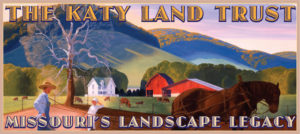
It’s been more than 10 years that the banners have been hanging at Treloar. In that time, there have been three or four versions, all featuring Haynes’ artwork. “Bryan paints what we want to conserve, and his art connects people to the landscape of Missouri — the rivers, hills and farms of Missouri — in a way that words can’t,” Dan Burkhardt explained.
Known for painting landscapes based on the history and geography of the area, Bryan’s focus is a movement that he calls “New Regionalism,” which is a continuation of the Regionalist movement practiced by famous Missouri artist Thomas Hart Benton in the 1930s and ’40s. “It’s very localized, and people like that. It follows with farmers markets and the buy local mentality.”
For Bryan, having his artwork displayed on the Treloar grain elevator has given him a new kind of exposure, and he couldn’t be prouder to be part of the project, which began as a way to promote the Katy Land Trust to create a permanent green-way along the Trail. “It’s about conservation and promoting the Missouri landscape, the beauty of Missouri, everything that I love. It just dovetails so nicely with everything that’s important to me,” he said.
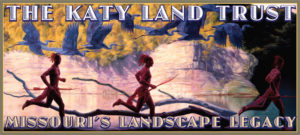
The first painting to be featured on the banners was called “Fence Builders,” an image he created while thinking about climate change. “The composition is divided, the sky is divided between this calm, blue sky and this horrible storm,” Bryan said. “It’s springtime, and there’s three men building a fence in the foreground, so at first you don’t notice the dichotomy in the background. It’s a particular farm in New Haven that as you drive along Highway 100 most people would recognize.”
One of Bryan’s favorite images to be featured on the banners is the one hanging on the side of the elevator facing the parking lot right now. It depicts a parade in Treloar with the Mercantile Building, grain elevators and a train in the background. “It shows Treloar and tradition,” Bryan said. The banner currently hanging on the side of the elevator that faces the trail features Bryan’s “Muleteer” painting, which illustrates a circa 1910 fall farm scene: A farmer plowing his field with a matched pair of Missouri mules. The message is simple: “Conserve Missouri Farmland.” Previous banners had phrases like “Keeping Space Open” and “Missouri’s Landscape Legacy.”
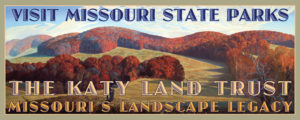
Cade Harp, a superintendent with Missouri State Parks assigned to the Mid-East Section of the Katy Trail which includes the area from Dutzow to Treloar, has only been with state parks for about six years, but in that time, he’s learned how popular the banners at Treloar are to trail users.
“They are a great asset to the Trail, because they depict the community around us,” Cade said. “The culture, the riparian environment that we work with Dan and Magnificent Missouri to reflect, the agricultural community that we work closely with. In a sense that people can visually realize while they’re visiting.
“We get visitors from all over the world, Europe, other counties, and all over Missouri, when they’re crossing the Trail, I often see them stop and read the exhibit there about the grain elevators and they can see the banners. It helps them visualize the partnership, the complexity of the Katy Trail and the meaning of it, how it was formed, what it means to the community, the citizens of Missouri and the people who use it.”
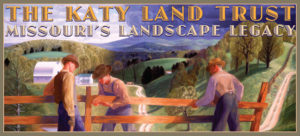
During special events held at Treloar (Sweet Corn Sunday, which this year is set for August 14 and the Elevator Party scheduled for October 16), Cade talks one-on-one with lots of Trail users and many comment on the beauty of the banners and share their appreciation for them. “It’s always positive. I’ve never had a negative encounter about the banners,” he said. “They kind of encapsulate, in some way, the relationships we have along the Katy Trail that we try to embrace and foster and continue, because they are very important to all of us.”
Of course, back in 2010 when Dan and Connie Burkhardt approached State Parks about getting permission to hang the banners on the grain elevator, which are part of the State Parks property, the idea was new, and the leadership was naturally hesitant. But once the application process was complete and all of the logistics about what the banners would look like and how they would be mounted were clear, everyone agreed the project had great potential. The banners, which are made of vinyl, are produced by Ziglin Signs in Washington, Mo., which also figured out how best to attach them to the elevator and how to install them. “They did a great job for us. It’s no small task to get them up there,” Dan remarked.
“It’s been a very positive experience for everyone involved,” Cade added.
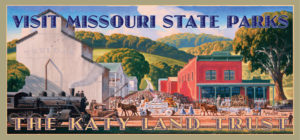
Bryan agreed. When he initially agreed to have his artwork featured on the banners, he underestimated how much feedback he would receive from trail users, but over the last decade, people have reached out to him with excitement just to say they saw the banners, or they’ll send him a photo of someone on a bicycle with the banners in the background and say, “Saw your stuff!” or “Saw your mural! Wow!”
“It’s all so gratifying really just to spread the word about Magnificent Missouri and the difference that conservation can make,” Bryan said. “If it helps beautify an area and brings attention and encourages people to take a selfie in front of the banners, then that’s what it’s about.”
